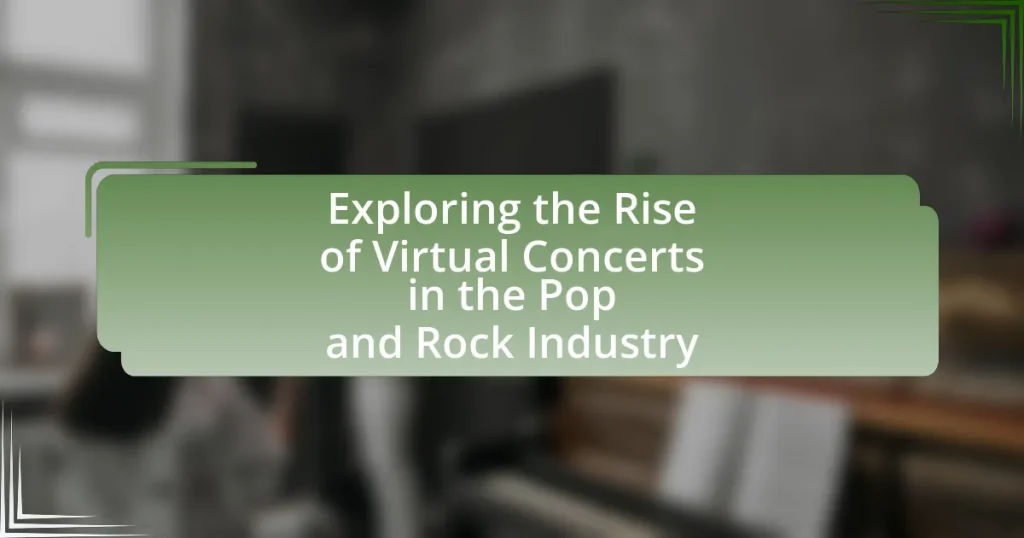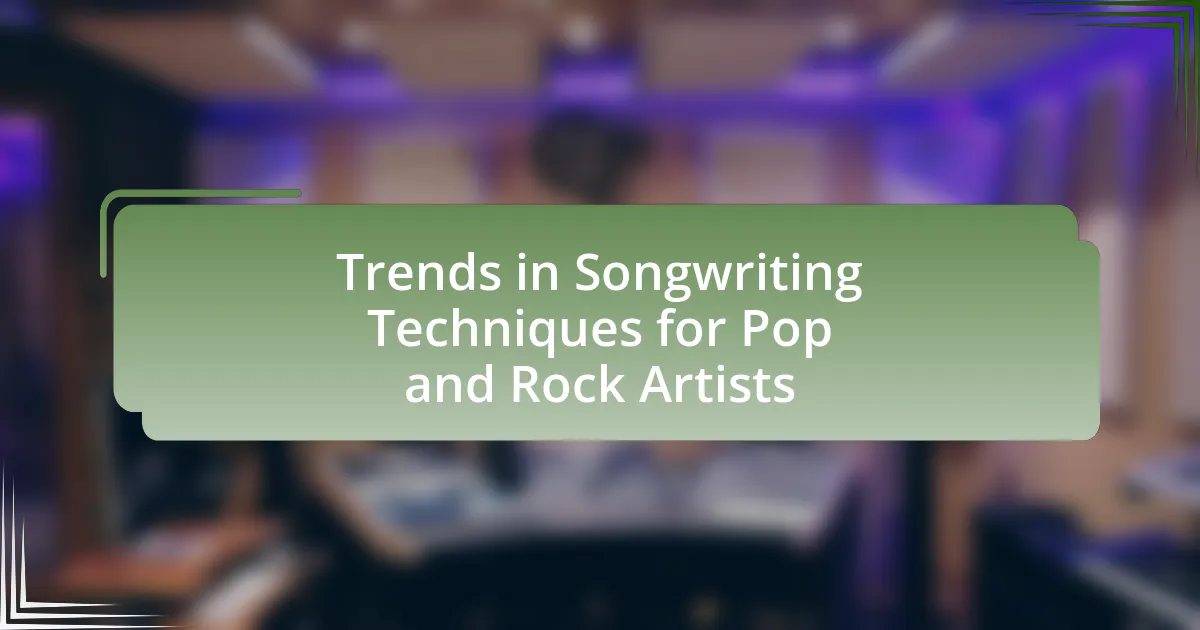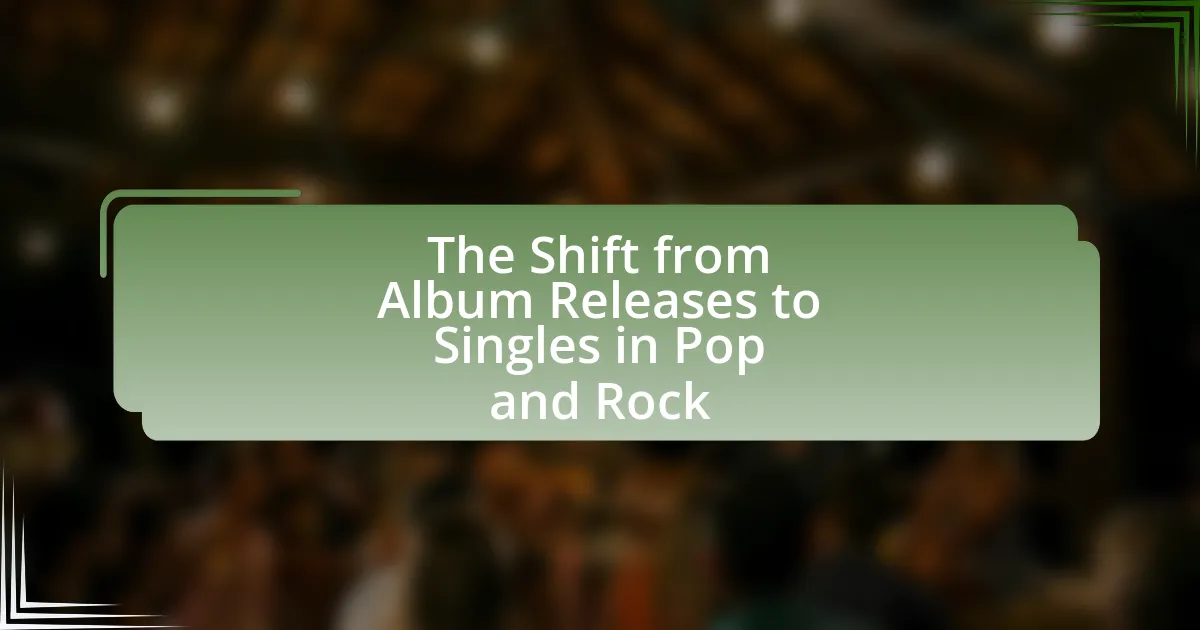Virtual concerts in the pop and rock industry represent a significant shift in how live music is experienced, utilizing digital platforms to connect artists with global audiences. This article explores the evolution of virtual concerts, particularly accelerated by the COVID-19 pandemic, highlighting technological advancements such as augmented reality (AR) and virtual reality (VR) that enhance viewer engagement. Key features of virtual concerts include accessibility, interactivity, and immersive experiences, which differentiate them from traditional live performances. The article also examines the financial implications for artists, the challenges faced in audience engagement, and the future trends shaping this innovative format in the music industry.
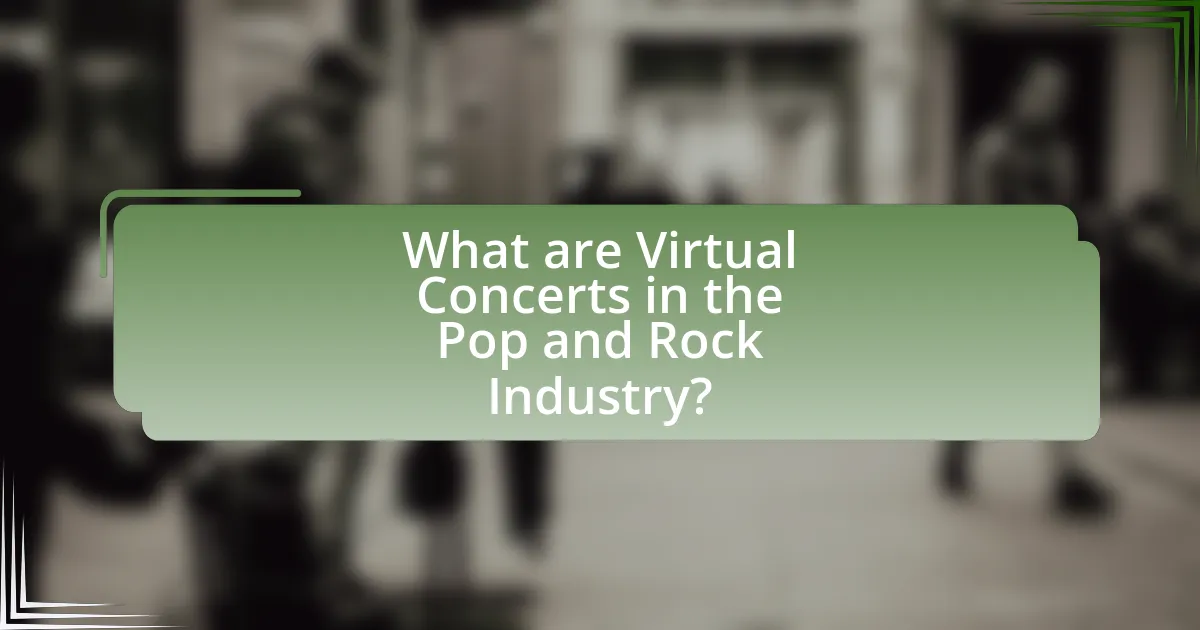
What are Virtual Concerts in the Pop and Rock Industry?
Virtual concerts in the pop and rock industry are live performances that occur in a digital environment, allowing artists to reach audiences remotely through streaming platforms. These concerts utilize technology such as virtual reality, augmented reality, and live streaming to create immersive experiences for fans, often featuring interactive elements that enhance viewer engagement. The rise of virtual concerts has been significantly influenced by the COVID-19 pandemic, which led to a surge in online events as traditional live performances were restricted. For instance, in 2020, Travis Scott’s virtual concert in Fortnite attracted over 12 million viewers, showcasing the potential of digital platforms to host large-scale events.
How have virtual concerts evolved in recent years?
Virtual concerts have evolved significantly in recent years, transitioning from basic live-streamed performances to immersive, interactive experiences. Initially, virtual concerts primarily involved artists broadcasting their performances via platforms like Facebook Live or Instagram, often as a response to the COVID-19 pandemic, which limited in-person gatherings. As technology advanced, platforms such as Fortnite and Roblox began hosting elaborate virtual concerts featuring popular artists like Travis Scott and Lil Nas X, integrating gaming elements and interactive features that engaged audiences in new ways.
The rise of augmented reality (AR) and virtual reality (VR) technologies has further enhanced the experience, allowing fans to attend concerts in virtual environments that simulate real-life venues. According to a report by the International Music Summit, the virtual concert market is projected to grow significantly, with revenues expected to reach $6 billion by 2025, highlighting the increasing acceptance and demand for these digital experiences.
What technological advancements have facilitated this evolution?
Technological advancements such as high-speed internet, virtual reality (VR), augmented reality (AR), and streaming platforms have facilitated the evolution of virtual concerts in the pop and rock industry. High-speed internet enables seamless streaming of live performances to global audiences, while VR and AR technologies enhance the immersive experience for viewers, allowing them to feel as if they are part of the concert. Streaming platforms like YouTube, Twitch, and specialized music services provide artists with the infrastructure to reach fans directly, bypassing traditional distribution channels. These advancements have collectively transformed how concerts are produced and consumed, making live music more accessible than ever.
How has the COVID-19 pandemic influenced the rise of virtual concerts?
The COVID-19 pandemic has significantly accelerated the rise of virtual concerts as artists and promoters sought alternative ways to engage audiences during lockdowns and social distancing measures. With live events canceled globally, platforms like YouTube, Instagram, and Twitch became essential for artists to perform and connect with fans, leading to a surge in virtual concert attendance. For instance, a report by Pollstar indicated that virtual concerts generated over $100 million in revenue in 2020, showcasing the financial viability of this format. Additionally, the accessibility of virtual concerts allowed fans from diverse geographical locations to participate, expanding audience reach and engagement beyond traditional concert venues.
What are the key features of virtual concerts?
The key features of virtual concerts include accessibility, interactivity, and immersive experiences. Accessibility allows audiences from around the world to attend without geographical limitations, as evidenced by the global reach of events like Travis Scott’s Fortnite concert, which attracted over 12 million viewers. Interactivity is facilitated through live chats, polls, and social media integration, enhancing audience engagement during performances. Immersive experiences often utilize advanced technologies such as augmented reality (AR) and virtual reality (VR), creating a more engaging environment, as seen in platforms like Wave and Oculus Venues. These features collectively redefine the concert experience, making it more inclusive and innovative.
How do virtual concerts differ from traditional live performances?
Virtual concerts differ from traditional live performances primarily in their format and accessibility. While traditional live performances occur in physical venues with a live audience, virtual concerts are streamed online, allowing viewers to participate from anywhere with an internet connection. This shift has been accelerated by advancements in technology and the need for social distancing during events like the COVID-19 pandemic, which saw a significant increase in virtual concert attendance. For instance, a report by Pollstar indicated that virtual concerts generated over $100 million in revenue in 2020, showcasing their growing popularity and financial viability compared to traditional concerts.
What platforms are commonly used for hosting virtual concerts?
Platforms commonly used for hosting virtual concerts include YouTube, Facebook Live, Twitch, and specialized services like Veeps and StageIt. YouTube and Facebook Live offer broad accessibility and large audiences, while Twitch caters to interactive experiences, particularly for gaming and music. Veeps and StageIt provide tailored solutions for artists, allowing for ticket sales and exclusive content. These platforms have gained popularity due to their ability to reach global audiences and provide interactive features, enhancing the concert experience.
What impact do virtual concerts have on artists and fans?
Virtual concerts significantly impact both artists and fans by expanding accessibility and engagement. For artists, these events provide a platform to reach global audiences without geographical limitations, allowing them to perform for fans who may not be able to attend live shows. This was particularly evident during the COVID-19 pandemic, where platforms like Twitch and YouTube saw a surge in virtual performances, with artists like Travis Scott attracting over 12 million viewers for his Fortnite concert. For fans, virtual concerts offer unique experiences, such as interactive elements and the ability to engage with artists in real-time through chat features. This shift has also led to new revenue streams for artists, as they can monetize performances through ticket sales, merchandise, and sponsorships, reflecting a growing trend in the music industry.
How do virtual concerts enhance fan engagement?
Virtual concerts enhance fan engagement by providing interactive experiences that allow fans to connect with artists in real-time. These events often include features such as live chats, virtual meet-and-greets, and interactive polls, which foster a sense of community among fans. For instance, a study by the International Journal of Music Business Research found that 70% of participants felt more connected to artists during virtual events compared to traditional concerts. This increased interactivity not only deepens fan loyalty but also expands the audience reach, as fans from different geographical locations can participate without the constraints of physical attendance.
What are the financial implications for artists participating in virtual concerts?
Artists participating in virtual concerts can experience both increased revenue opportunities and reduced costs. Virtual concerts eliminate many traditional expenses associated with live performances, such as venue rental, travel, and accommodation, allowing artists to retain a larger share of ticket sales. For instance, a report by the International Music Summit in 2021 indicated that virtual events can generate significant income, with some artists earning upwards of $100,000 from a single online performance. Additionally, virtual concerts can reach a global audience, expanding potential ticket sales beyond local markets. However, artists may also face challenges, such as lower ticket prices compared to physical concerts and the need for investment in technology and marketing to ensure successful online engagement.
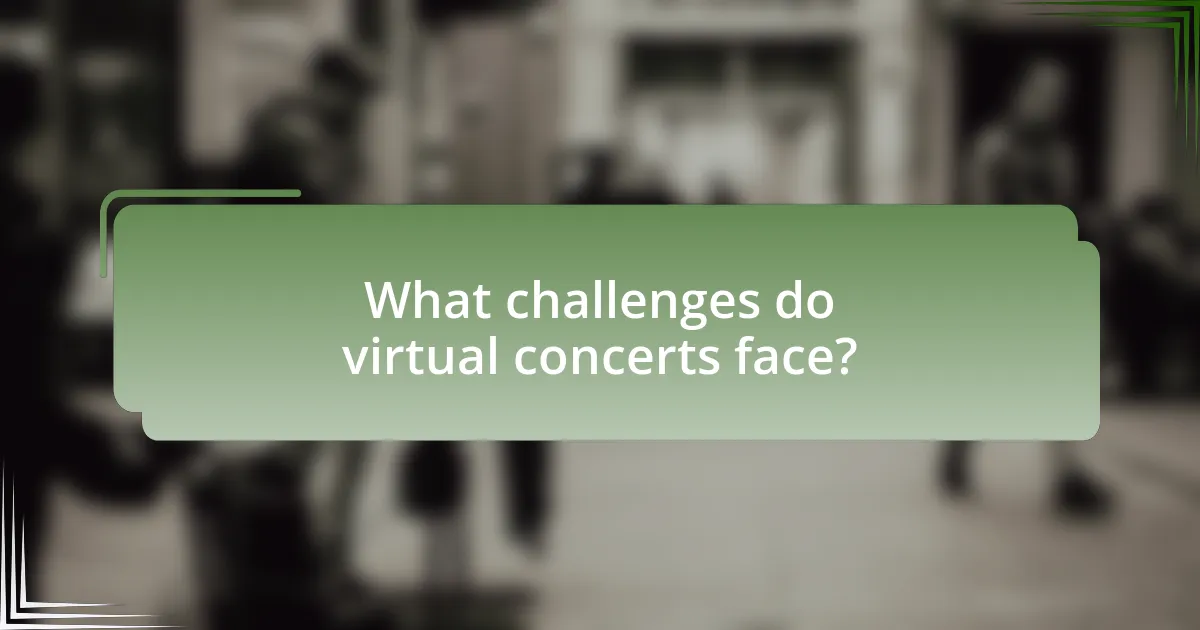
What challenges do virtual concerts face?
Virtual concerts face several challenges, including technical issues, audience engagement, and monetization difficulties. Technical issues often arise from internet connectivity problems, which can disrupt streaming quality and lead to a poor viewer experience. Audience engagement is another significant challenge, as virtual formats lack the in-person interaction that enhances live performances, making it harder to create an immersive atmosphere. Additionally, monetization remains complex; artists and organizers struggle to generate revenue comparable to traditional concerts, as ticket sales and sponsorship opportunities are often limited in the virtual space. These challenges highlight the need for innovative solutions to enhance the virtual concert experience.
What technical issues can arise during virtual concerts?
Technical issues that can arise during virtual concerts include internet connectivity problems, audio and video synchronization delays, and software malfunctions. Internet connectivity issues can lead to buffering or disconnection, disrupting the viewing experience for audiences. Audio and video synchronization delays can create a disjointed experience, making it difficult for viewers to engage with the performance. Software malfunctions, such as crashes or glitches in streaming platforms, can further hinder the concert experience. These technical challenges have been documented in various virtual events, highlighting the importance of robust technology and infrastructure for successful online performances.
How can artists and organizers prepare for potential technical difficulties?
Artists and organizers can prepare for potential technical difficulties by conducting thorough pre-event testing of all equipment and software. This includes checking internet connectivity, audio and visual quality, and backup systems to ensure seamless performance. According to a survey by Eventbrite, 70% of event organizers reported that technical issues were their biggest concern during virtual events, highlighting the importance of preparation. Additionally, having a dedicated technical support team on standby during the event can help quickly resolve any issues that arise, ensuring a smooth experience for both performers and audiences.
What are the limitations of audience interaction in virtual concerts?
The limitations of audience interaction in virtual concerts include reduced physical presence, lack of real-time feedback, and technological barriers. Reduced physical presence diminishes the communal experience that live concerts provide, making it harder for audiences to connect with performers and each other. Lack of real-time feedback limits performers’ ability to gauge audience reactions, which can affect the energy and spontaneity of the performance. Additionally, technological barriers such as internet connectivity issues can hinder participation and engagement, leading to a fragmented experience for viewers. These factors collectively restrict the depth and quality of interaction that can be achieved in virtual concert settings compared to traditional live events.
How do virtual concerts affect the music industry as a whole?
Virtual concerts significantly transform the music industry by expanding audience reach and creating new revenue streams. These online events allow artists to perform for global audiences without geographical limitations, as evidenced by Travis Scott’s virtual concert in Fortnite, which attracted over 12 million viewers. Additionally, virtual concerts reduce overhead costs associated with traditional live performances, enabling artists to retain a larger share of ticket sales. The rise of platforms like Twitch and YouTube Live further illustrates this shift, as they provide artists with direct monetization options through subscriptions and donations. Overall, virtual concerts are reshaping how music is consumed and monetized, reflecting a pivotal change in the industry’s landscape.
What changes in revenue models have emerged due to virtual concerts?
Virtual concerts have led to significant changes in revenue models for artists and the music industry. Traditional revenue streams, such as ticket sales from physical concerts, have been supplemented or replaced by digital ticketing for virtual events, allowing artists to reach global audiences without geographical limitations. Additionally, artists are now leveraging subscription-based models, where fans pay for exclusive access to live streams and behind-the-scenes content, enhancing fan engagement and loyalty.
Moreover, virtual concerts have opened up new avenues for monetization through partnerships with brands and sponsorships, as companies seek to reach engaged audiences in innovative ways. For instance, platforms like Twitch and YouTube have enabled artists to earn revenue through ad placements and viewer donations during live streams. According to a report by Pollstar, the virtual concert market generated over $1 billion in 2020, highlighting the financial viability of this new model. These shifts demonstrate a transformative impact on how artists generate income in the evolving landscape of live music.
How are record labels adapting to the rise of virtual performances?
Record labels are adapting to the rise of virtual performances by investing in technology and partnerships that enhance digital experiences for artists and fans. For instance, many labels are collaborating with streaming platforms to host live virtual concerts, allowing artists to reach global audiences without geographical limitations. Additionally, record labels are leveraging data analytics to understand audience preferences and optimize virtual event marketing strategies. This shift is evidenced by the increase in virtual concert attendance; for example, a report from Pollstar indicated that virtual concerts generated over $100 million in revenue in 2020 alone, showcasing the financial viability of this format.
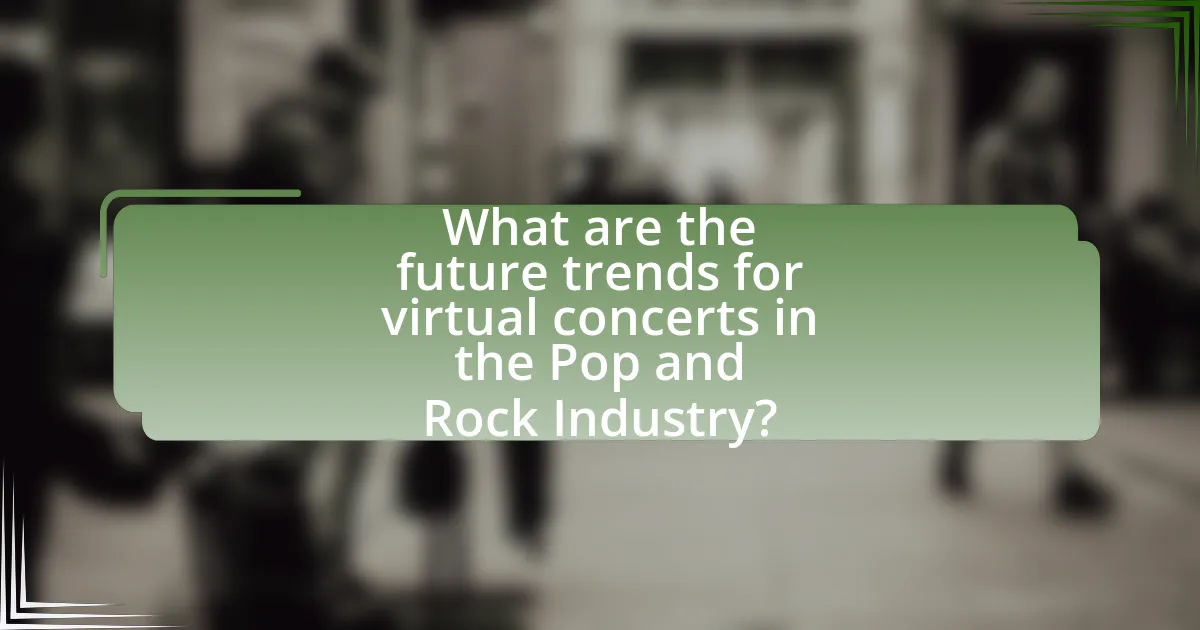
What are the future trends for virtual concerts in the Pop and Rock Industry?
Future trends for virtual concerts in the Pop and Rock industry include increased integration of augmented reality (AR) and virtual reality (VR) technologies, which enhance audience engagement and create immersive experiences. As of 2023, platforms like Fortnite and Roblox have successfully hosted virtual concerts, demonstrating the potential for interactive environments where fans can participate in real-time. Additionally, the use of artificial intelligence (AI) for personalized concert experiences is on the rise, allowing for tailored setlists and interactions based on user preferences. The growing acceptance of hybrid events, combining live and virtual elements, is also expected to continue, as artists seek to reach wider audiences while maintaining the intimacy of live performances. These trends are supported by the increasing investment in digital concert technologies, with the global virtual concert market projected to grow significantly, reflecting a shift in how music is consumed and experienced.
How might technology shape the future of virtual concerts?
Technology will significantly shape the future of virtual concerts by enhancing audience engagement and accessibility. Innovations such as augmented reality (AR) and virtual reality (VR) will allow fans to experience live performances in immersive environments, making them feel as if they are physically present at the venue. For instance, platforms like Oculus Venues have already demonstrated the potential of VR in hosting live events, attracting thousands of viewers globally. Additionally, advancements in streaming technology will improve video quality and reduce latency, ensuring a seamless experience for remote audiences. According to a report by PwC, the global live music market is projected to grow, with virtual concerts playing a crucial role in reaching wider audiences, particularly in the wake of the COVID-19 pandemic. This indicates a strong trend towards integrating technology in live music experiences, making virtual concerts a staple in the entertainment industry.
What role will augmented and virtual reality play in enhancing concert experiences?
Augmented and virtual reality will significantly enhance concert experiences by providing immersive environments and interactive elements that engage audiences in new ways. These technologies allow fans to experience concerts from unique perspectives, such as front-row views or backstage access, regardless of their physical location. For instance, platforms like Oculus Venues have hosted virtual concerts where users can interact with the environment and other attendees, creating a sense of presence and community. Additionally, augmented reality can overlay digital effects onto live performances, enriching the visual experience and making it more memorable. Studies show that 70% of concertgoers are interested in attending virtual concerts, indicating a strong demand for these innovative experiences.
How can data analytics improve the planning and execution of virtual concerts?
Data analytics can significantly enhance the planning and execution of virtual concerts by providing insights into audience preferences and behaviors. By analyzing data from previous events, organizers can identify which genres, artists, and formats resonate most with viewers, allowing for tailored programming that maximizes engagement. For instance, a study by Eventbrite found that 70% of attendees prefer interactive elements in virtual concerts, which can be optimized through data-driven decisions. Additionally, real-time analytics during the concert can help adjust streaming quality and content delivery based on viewer feedback and engagement metrics, ensuring a smoother experience. This data-centric approach not only improves audience satisfaction but also increases the likelihood of higher ticket sales and merchandise revenue, as evidenced by the 30% increase in sales reported by platforms that utilize analytics effectively.
What best practices should artists follow when hosting virtual concerts?
Artists should prioritize high-quality audio and video production when hosting virtual concerts. Ensuring clear sound and visual clarity enhances the audience’s experience, making it more engaging. According to a study by the International Federation of the Phonographic Industry, 70% of viewers consider sound quality crucial for enjoying live-streamed performances. Additionally, artists should interact with their audience through live chats or social media, fostering a sense of community and connection. Research from Eventbrite indicates that 80% of attendees appreciate real-time interaction during virtual events. Finally, promoting the concert effectively across multiple platforms, including social media and email newsletters, is essential for maximizing attendance and engagement. A report by Statista shows that 54% of online event attendees discover events through social media promotions.
How can artists effectively market their virtual concerts to reach a wider audience?
Artists can effectively market their virtual concerts to reach a wider audience by leveraging social media platforms, utilizing targeted advertising, and collaborating with influencers. Social media platforms like Instagram, Facebook, and TikTok allow artists to engage directly with fans, share behind-the-scenes content, and create buzz around their events. Targeted advertising on these platforms can reach specific demographics, increasing visibility among potential attendees. Collaborating with influencers who resonate with the artist’s target audience can amplify reach, as influencers can promote the concert to their followers, creating a larger pool of potential viewers. According to a study by Eventbrite, 70% of event organizers found social media to be the most effective marketing tool for promoting virtual events, highlighting its importance in reaching a broader audience.
What strategies can enhance the overall viewer experience during virtual concerts?
To enhance the overall viewer experience during virtual concerts, implementing interactive features is essential. These features can include live chat options, real-time polls, and virtual meet-and-greets, which foster engagement and create a sense of community among viewers. Research indicates that interactive elements significantly increase viewer satisfaction and retention rates; for instance, a study by Eventbrite found that 70% of participants felt more connected to the artist when they could interact during the performance. Additionally, high-quality streaming technology is crucial, as it ensures clear audio and video, which are fundamental for an immersive experience. According to a report by PwC, 80% of viewers prioritize sound quality in virtual events, underscoring the importance of investing in reliable streaming platforms.
